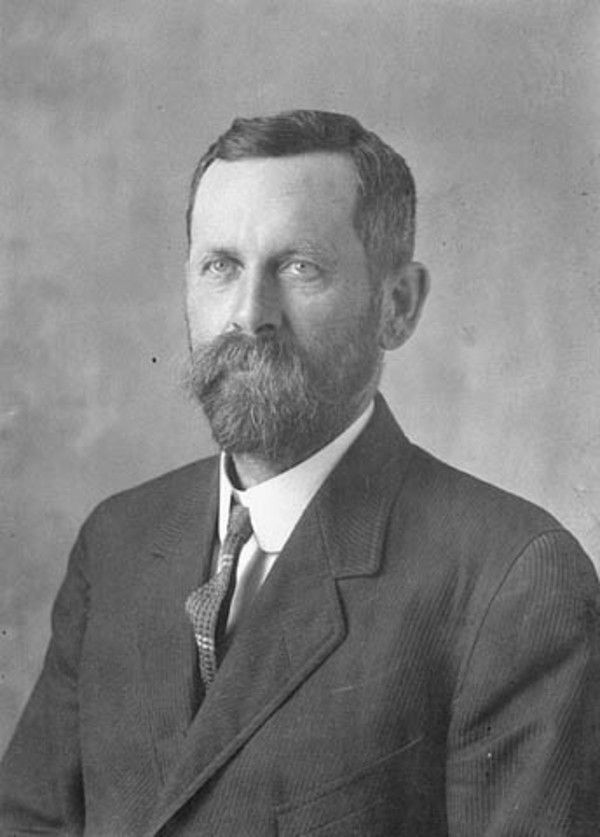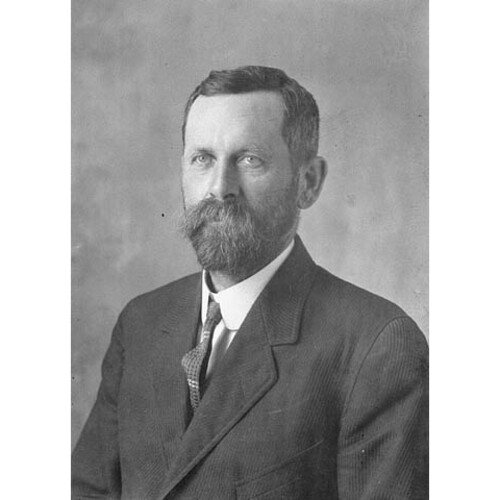THOMSON, LEVI, farmer, lawyer, and politician; b. 17 Feb. 1855 in Hillsburgh (Erin), Upper Canada, son of John Thomson and Sarah McMillan; m. 4 March 1884 Mabel (Mable) Maud (Maude) Perley (d. 23 April 1954) in Wolseley (Sask.), and they had four sons and one daughter; d. there 14 April 1938.
Levi Thomson grew up on his family’s farm in Wellington County and gained his early education at the Hillsburgh public school and Rockwood Academy [see William Wetherald*]. He then moved to Toronto to study law and was articled to the firm of William Henry Beatty* and Edward Marion Chadwick*. Before completing his legal training, however, Thomson decided to become a farmer in western Canada. He was better prepared for this role than most other settlers in the region: he not only knew how to operate a farm, but he was also able to buy all the necessary equipment in Winnipeg before setting out westward in 1882 from Brandon, along the future path of the main Canadian Pacific Railway (CPR) line. Thomson acquired land north of Wolseley, a new town named for Garnet Joseph Wolseley* in what would become southern Saskatchewan, and in short order he was the proud owner of a successful farm. Two years later he married Mabel Maud Perley, daughter of William Dell Perley, a future mp and senator for Wolseley, and they would have five children.
Thomson became involved in public affairs and community service soon after he arrived in Wolseley. High tariffs and inadequate rail service were the bane of prairie farmers in the 1880s, and they responded by taking collective action to lobby the federal government and battle the monopolistic behaviour of the CPR. The Regina Leader-Post would later observe that Thomson was “closely associated with all western agricultural movements”; from 1885 to 1888 he was the first president of the Wolseley Agricultural Society, and in 1907 he would become vice-president of the Saskatchewan Grain Growers’ Association [see Edward Alexander Partridge; Frederick William Green*]. He was also a municipal councillor in Wolseley between 1889 and 1903, was elected mayor in 1904, and was prominent in his church (he belonged to the Disciples of Christ faith but attended the Wolseley Union Church) and in the temperance movement.
After a decade as a farmer Thomson decided to return to the study of law, perhaps because he had a sense of unfinished business. In the spring of 1894 he passed his final examinations and was admitted to the bar of the North-West Territories. Although he continued farming, Thomson set up his own practice in Wolseley, which offered several advantages to an aspiring lawyer: it was the site of a new courthouse designed under the direction of Thomas Fuller*, chief architect of the Department of Public Works, in a densely settled area on the CPR’s main line. He later welcomed two partners, David Porteous Kennedy and then Alfred Harvey Hord, into what became the flourishing firm of Thomson, Kennedy, and Hord. Because of his location and standing in the community, Thomson was a logical candidate to be appointed crown prosecutor in 1897 for the district of Eastern Assiniboia. He resigned this post in order to stand as the Liberal candidate for Qu’Appelle in the federal election of 1904, championing the cause of free trade, but was defeated by just 28 votes. A year later he contested Wolseley for Thomas Walter Scott’s Liberals in Saskatchewan’s first provincial election, only to lose by the even narrower margin of 20 votes. Thomson was then made crown prosecutor for the district of Moosomin, and he would serve in this role until 1911.
In 1908 it became clear that Thomson’s good reputation had spread beyond Wolseley when he was named to the inaugural board of governors of the University of Saskatchewan [see James Clinkskill]. Its first order of business was to select the university’s location, a contentious matter that ultimately came down to a choice between Saskatoon and Regina, the capital. The board’s deliberations were supposed to be kept secret, but Thomson later revealed that he had cast the deciding vote in favour of Saskatoon. Regina is closer to Wolseley, but Thomson, a loyal party man, probably made his choice at the instigation of Premier Scott, who had appointed him to the board and who evidently did not want both the Legislative Assembly and the university to be located there.
In 1911 Thomson resigned as crown prosecutor for Moosomin and ran again for the Liberals in Qu’Appelle in the federal election of that year. This time he won, but because Sir Wilfrid Laurier*’s Liberals were defeated by Robert Laird Borden’s Conservatives, Thomson sat on the opposition benches. In the wartime election of 1917 he stood unopposed as a Unionist Liberal who supported the government’s conscription policy, perhaps in part because one of his sons, Edwin Ernest, had been wounded earlier that year while serving with the Canadian Expeditionary Force’s 46th Infantry Battalion [see Reginald John Godfrey Bateman*; Hugh Cairns*]. After the war Thomson joined the agrarian-based Progressives [see Thomas Wakem Caldwell] and served as party whip for the rest of the parliamentary session. He left politics in 1921 and returned to his legal practice (he had been made a kc in 1913) in Wolseley. Levi Thomson retired from his firm in 1928 and died at his home following a long illness on 14 April 1938, having enjoyed a successful career as a farmer, lawyer, and politician.
Leader-Post (Regina), 14, 18 April 1938. Manitoba Free Press, 19 May 1894, 12 Jan. 1904. Morning Leader (Regina), 6 Jan. 1904; 8, 22 April 1909; 21, 22 Sept. 1911; 17 Dec. 1917. John Hawkes, The story of Saskatchewan and its people (3v., Regina, 1924), 3. Pioneers and prominent people of Saskatchewan (Winnipeg and Toronto, 1924). J. M. Pitsula, Higher education policy in Saskatchewan and the legacy of myth (Regina, 2003). Ashley Thomson, “Levi Thomson and his descendants,” in Wolseley & Dist. Hist. Book Committee, Bridging the past: Wolseley & district, 1880–1980 (Wolseley, Sask., 1981), 464.
Cite This Article
Ken Leyton-Brown, “THOMSON, LEVI,” in Dictionary of Canadian Biography, vol. 16, University of Toronto/Université Laval, 2003–, accessed December 30, 2025, https://www.biographi.ca/en/bio/thomson_levi_16E.html.
The citation above shows the format for footnotes and endnotes according to the Chicago manual of style (16th edition). Information to be used in other citation formats:
| Permalink: | https://www.biographi.ca/en/bio/thomson_levi_16E.html |
| Author of Article: | Ken Leyton-Brown |
| Title of Article: | THOMSON, LEVI |
| Publication Name: | Dictionary of Canadian Biography, vol. 16 |
| Publisher: | University of Toronto/Université Laval |
| Year of publication: | 2019 |
| Year of revision: | 2019 |
| Access Date: | December 30, 2025 |





